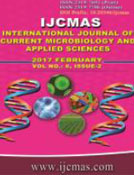


 National Academy of Agricultural Sciences (NAAS)
National Academy of Agricultural Sciences (NAAS)

|
PRINT ISSN : 2319-7692
Online ISSN : 2319-7706 Issues : 12 per year Publisher : Excellent Publishers Email : editorijcmas@gmail.com / submit@ijcmas.com Editor-in-chief: Dr.M.Prakash Index Copernicus ICV 2018: 95.39 NAAS RATING 2020: 5.38 |
The field experiment was laid out in randomized block design with three replications to investigate the morpho-physiological traits and productivity of garden pea (Pisum sativum L. as influenced by the application of potassium humate. The experiment consisted seven treatment combinations and each treatment has common used of potassium humate 4.5 @ 5 lit/acre before basal dose of manure/fertilizers, which denoted by SA- Soil application, FA- foliar application and FA- foliar spray, described as T1- control, T2- SA + FS@5:250 of water after one month of 1st application, T3- SA+ 2nd SA@ 5:150 after one month of FA, T4- SA+ FS @ 5:250 after 45 days of 1st application, T5- SA+ SA @ 5: 150 + after 30 days of 1st application + FA @ 3: 150 after 45 days of 2nd application, T6- SA+ FS @ 5: 250 immediately after 1st picking and T7- SA + FS @ 5: 250 after 15 days of 1st picking during rabi 2014-15. Among the different treatment combinations, T5 had showed significant difference during phenophasic period except emergence and tendril formation, resulted highest yield attributing characters like number of nodes/ plant, filled pods/ plant (20.83), Seeds/ pod (4.51), pod length, green pod yield/ plant and seed yield (18.31 g/ plant & 20.38 qtl/ha) of garden pea over control; while, it was remained at par in terms of biological yield (41.55 qtl/ha) from T4 (42.05 qtl/ha). The maximum harvest index recorded under T3. Moreover, seed index was found to be non-significant but maximum with other treatments.
 |
 |
 |
 |
 |